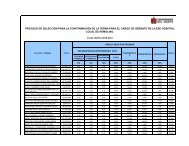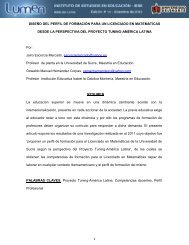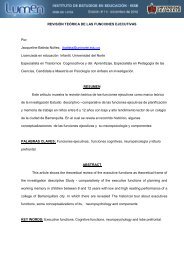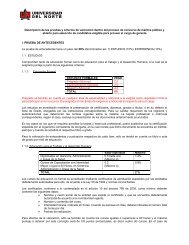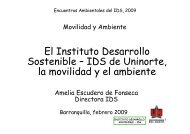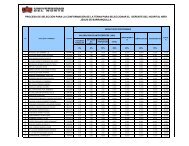Determinantes de la informalidad laboral y el subempleo en las ...
Determinantes de la informalidad laboral y el subempleo en las ...
Determinantes de la informalidad laboral y el subempleo en las ...
Create successful ePaper yourself
Turn your PDF publications into a flip-book with our unique Google optimized e-Paper software.
<strong>Determinantes</strong> <strong>de</strong> <strong>la</strong> <strong>informalidad</strong> <strong>la</strong>boral y <strong>el</strong> <strong>subempleo</strong> <strong>en</strong><br />
<strong>la</strong>s áreas metropolitanas <strong>de</strong> Barranquil<strong>la</strong>, Cartag<strong>en</strong>a y Montería<br />
Anexos<br />
Anexo 1: Estimación <strong>de</strong> un mo<strong>de</strong>lo probit bivariado<br />
Al igual que un mo<strong>de</strong>lo probit, uno biprobit se estima mediante <strong>el</strong> método <strong>de</strong><br />
máxima verosimilitud, que maximiza <strong>la</strong> probabilidad que <strong>el</strong> parámetro estimado<br />
sea igual al parámetro pob<strong>la</strong>cional. Para realizar dicha estimación partimos <strong>de</strong> <strong>la</strong><br />
función <strong>de</strong> distribución normal bivariante igual a:<br />
Prob(X 1 < X 2 < x 2 ) =<br />
Ø 2 (z 1 , z 2 , ρ) dz 1 dz 2 ,<br />
Que se repres<strong>en</strong>tará como: θ 2<br />
(x 1<br />
, x 2<br />
,ρ). La <strong>de</strong>nsidad es:<br />
Ø 2<br />
(x 1<br />
, x 2<br />
,ρ)=<br />
e - (x 2 1<br />
2<br />
+ x 2 2ρx 1<br />
x 2<br />
)(1-ρ 2 )<br />
2π(1- ρ 2 ) 1/2<br />
Para construir <strong>la</strong> función <strong>de</strong> verosimilitud logarítmica, l<strong>la</strong>maremos q i1<br />
= 2y i1<br />
-1 y q i2<br />
=<br />
2y i2<br />
-1. De este modo, q ij<br />
= 1 ó-1 si y ij<br />
= 0, para y ij<br />
= 0. L<strong>la</strong>memos ahora :<br />
z ij<br />
= β' j<br />
x ih<br />
; w ij<br />
= q ij<br />
z ij<br />
don<strong>de</strong> j=1,2; ρ i<br />
* = q i1<br />
q i2<br />
ρ.<br />
Las probabilida<strong>de</strong>s que aparec<strong>en</strong> <strong>en</strong> <strong>la</strong> función <strong>de</strong> verosimilitud son:<br />
Prob(Y 1<br />
= y i1<br />
,Y 2<br />
= y i2<br />
) = θ 2<br />
(w i1<br />
, w i2<br />
, ρ i*<br />
)<br />
En esta ecuación quedan recogidos todos los cambios <strong>de</strong> signo necesarios para calcu<strong>la</strong>r<br />
<strong>la</strong>s probabilida<strong>de</strong>s <strong>de</strong> que <strong>la</strong>s y sean iguales a 0 y 1. De este modo,<br />
lnL=<br />
n<br />
i=1<br />
ln θ 2 ( w i1 , w i2 , ρ i* )<br />
Las <strong>de</strong>rivadas <strong>de</strong> <strong>la</strong> función <strong>de</strong> verosimilitud logarítmica pue<strong>de</strong>n expresarse como:<br />
=<br />
q g x , j = 1, 2,<br />
θ₂<br />
=<br />
q g Ø₂<br />
θ₂<br />
42<br />
IEEC 32.indd 42<br />
19/01/2011 04:39:36 p.m.



